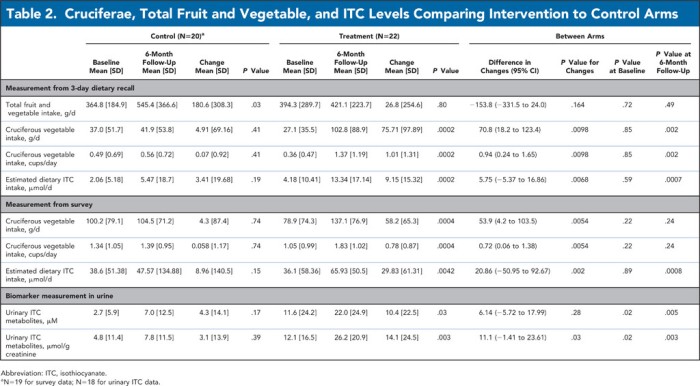A 2024 clinical trial investigated effects of people adding a cup of cruciferous vegetables to their daily diet for six months:
“We developed a 6-month behavioral dietary intervention (Power to Redefine Your Health [POW-R Health]) designed to increase Cruciferae intake and isothiocyanate (ITC) levels in non–muscle-invasive bladder cancer (NMIBC) survivors, with the long-term goal of reducing bladder cancer recurrence, progression, and mortality.
Orally ingested ITCs are rapidly and almost exclusively delivered to the bladder and concentrated in the urine, showing 2 to 3 orders of magnitude higher concentration of ITCs and metabolites in the urine than in the plasma within 3 hours of dosing. Storage of urine in the bladder further enhances exposure of malignant cells to ITCs.
We estimated dietary ITC intake and measured urinary ITC levels. With the exception of urinary ITC levels in µM, the treatment arm had a significantly higher increase in levels in all variables compared with the control arm from baseline to 6-month follow-up.

Our POW-R Health intervention increased Cruciferae intake by 0.94 cups/day and urinary ITC levels by 11.1 μmol/g creatinine compared with the control arm, with an average increase of urinary concentration of 10.4 μM, the desirable dose level of urinary ITCs needed to stop or kill at least 50% of bladder cancer cells in in vitro models. To our knowledge, this is the only study that showed an intervention’s success in significantly and meaningfully increasing both Cruciferae intake and urinary ITC levels among NMIBC survivors.
Our simple dietary intervention only requires NMIBC survivors to consume 1 cup of Cruciferae a day, is of low cost to participants (cost of Cruciferae), and is easily accessible (available at grocery stores). If a future RCT demonstrates that the intervention significantly reduces bladder cancer recurrence and progression, it would be an easily scalable strategy to prevent NMIBC recurrence and progression, which occurs within 5 years in most NMIBC survivors.”
https://jnccn.org/view/journals/jnccn/aop/article-10.6004-jnccn.2023.7086/article-10.6004-jnccn.2023.7086.xml “Outcomes of a Dietary Intervention to Reduce Bladder Cancer Recurrence and Progression in Survivors of Non–Muscle-Invasive Bladder Cancer”
These researchers took a result of “an average increase of urinary concentration of 10.4 μM” and touted it as evidence of the intervention’s success. The first paragraph of clinical trial NCT04548193’s primary objective was:
“Develop an evidence-based behavioral intervention to increase cruciferous vegetable intake, with the goal of attaining desirable urinary isothiocyanates (ITC) levels effective for anti-cancer activities.”
No mention in this study’s Discussion section of why 10.4 ± 22.5 µM was so wildly variable. After all, nobody’s measurements of excreted ITCs (aka bioavailability) were below zero as the standard deviation implies (10.4 – 22.5 µM ?).
How much did “estimated dietary ITC intake” contribute to variability in this trial’s measurement goal? Reference 26 “Total isothiocyanate yield from raw cruciferous vegetables commonly consumed in the United States” shared a few coauthors with this study, and had items such as:
“We observed up to 345-fold difference in isothiocyanate yield among nine samples of mustard green (ranging from 0.4 to 137.9 μmol/100g wet weight).”
Reference 25 “Effects of cooking methods on total isothiocyanate yield from cruciferous vegetables” also shared a few coauthors with this study, and had items such as:
“The efficiency and amount of ITCs generated by gastrointestinal microflora could be relatively low and vary substantially by individuals.”
But differences in cooking methods and raw cruciferous vegetables weren’t the only explanations for this primary outcome’s wild variability. These researchers knew or should have known about the 2016 https://onlinelibrary.wiley.com/doi/abs/10.1002/mnfr.201600766 “Stabilized Sulforaphane for Clinical Use: Phytochemical Delivery Efficiency” (not freely available).
Per that study of 10 healthy people’s metabolisms after ingesting a 200 μmol isothiocyanate sulforaphane amount (35 mg), urinary % of dose amount excreted ranged from 19.5% to 86.9%. Statistics wouldn’t add any plausible explanations of why there were >four times individual differences in ITC bioavailability.
So we’ll have to wait for follow-on studies.
Kingfisher
